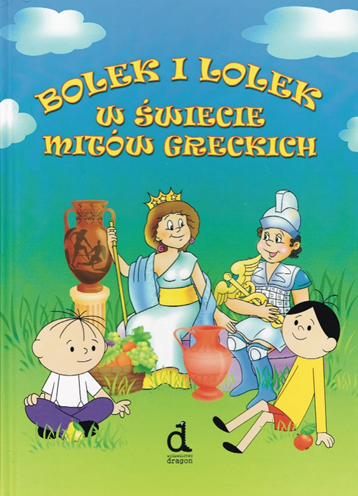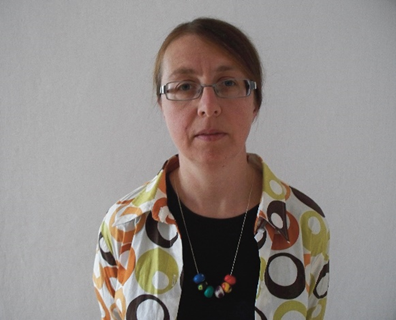Title of the work
Country of the First Edition
Country/countries of popularity
Original Language
First Edition Date
First Edition Details
Iwona Czarkowska, Bolek i Lolek w świecie mitów greckich. Bielsko-Biała: Wydawnictwo Dragon, 2009, 31 pp.
ISBN
Genre
Time-travel fiction
Target Audience
Children
Cover

Courtesy of the publisher.
Author of the Entry:
Summary: Karolina Zieleniewska, University of Warsaw, k.zieleniewska@hotmail.com
Analysis: Marta Pszczolińska, University of Warsaw, m.pszczolinska@al.uw.edu.pl
Peer-reviewer of the Entry:
Katarzyna Marciniak, University of Warsaw, kamar@al.uw.edu.pl
Elżbieta Olechowska, University of Warsaw, elzbieta.olechowska@gmail.com

Photograph courtesy of the Author.
Iwona Czarkowska
, b. 1970
(Author)
A writer and editor of children’s magazines. Iwona Czarkowska graduated in journalism from the University of Warsaw in 1994. She started her career writing about media and film. Since 2000, she has been writing for the youngest readers. She worked for many various magazines, e.g., “DD Reporter,” “5–10–15,” “Ciuchcia,” “Czarodziejskie opowieści,” “Nasze dobranocki” and “Świerszczyk.” She is also known as author of over a dozen books for the youngest readers: Biuro zagubionych zabawek [The Office of Lost Toys], 2007; a series on Bolek and Lolek’s new adventures (including Bolek i Lolek w świecie mitów greckich [Bolek and Lolek in the World of Greek Myths], 2009); Kocia Odkrywalnia Tajemnic [A Place Where Cats Uncover Secrets], 2009; Duchy ze Wzgórza Rabowników [Ghosts from Robber Hill], 2011; Bajeczki dla dziewczynek [Little Fables for Little Girls], 2011; Kazio i skrzynia pełna wampirów [Kazio and a Casket Full of Vampires], 2011; Kazio i szkoła pełna wampirów [Kazio and a School Full of Vampires], 2012; Kazio w miasteczku pełnym wampirów [Kazio in a Small Town Full of Vampires], 2012; Cień anioła [Shade of an Angel], 2012; Antoś Żeberko, Kuba i Gang Porywaczy Skarpetek [Tony Ribs, Jake and the Gang of Sock Thieves], 2012, etc.
In 2009, she received a mention in the Telbit Best Book for Young Readers Contest, and in 2010, a 3rd prize in the 2nd edition of Astrid Lindgren Competition for a contemporary book for children and young readers organized by the Fundacja ABCXXI – Cała Polska czyta dzieciom [Foundation ABCXXI – All of Poland Reads to Kids]. Czarkowska also translates English and Russian literature for children.
Source:
Bio prepared with the use of the material kindly provided by the Author.
Bio prepared by Karolina Zieleniewska, University of Warsaw, k.zieleniewska@hotmail.com

Maria Molenda (Illustrator)
Summary
Based on: Katarzyna Marciniak, Elżbieta Olechowska, Joanna Kłos, Michał Kucharski (eds.), Polish Literature for Children & Young Adults Inspired by Classical Antiquity: A Catalogue, Faculty of “Artes Liberales”, Warsaw: University of Warsaw, 2013, 444 pp.
Bolek and Lolek are two little boys who, known as characters from a famous Polish cartoon series initiated by Władysław Nehrebecki (1923–1978), are featured in an illustrated book for children. They get a birthday gift from their grandpa. It is not an electric train or a birthday cake, as they expected, but a mysterious book. Lolek starts to read it and is transported, together with Bolek, to the world of Greek mythology. They visit Olympus and meet heroes and gods: Zeus, Hera, Hermes, Achilles, etc. They also learn the most popular myths about the Trojan War, Theseus and Ariadne, Sisyphus, and others. The book is aimed at very young children. It contains simplified versions of Greek myths with some humorous elements and omits any scenes of violence.
Analysis
Greek myths are introduced to children with the help of their favourite characters. Bolek and Lolek characters were created by Władysław Nehrebecki and were initially based on real boys – his sons. Nehrebecki reused the protagonists’ names from the movie Bolek i Lolek from 1936, directed by Michał Waszyński, with Adolf Dymsza playing both title roles. The Bolek i Lolek cartoon TV series has been very popular in Poland, with over 150 episodes and a few big-screen movies. The characters were also protagonists of colourful books based on particular TV episodes, unrelated to classical antiquity but rather to Bolek and Lolek’s non-mythological adventures. This book uses the original characters of Bolek and Lolek but is a stand-alone story that has never been animated. The illustrations reuse the original cartoon characters as they were created for the animation. Other characters, however, are drawn differently and do not correspond either to the illustrations in the previous books or the cartoon’s layout. As intended by the original creator, the protagonists are easy to identify with, and when they extend their knowledge, the child readers learn without realising it.
The references to classical mythology are evident at two levels. The first level consists of what the boys already know about mythology, the second – is their time travel destination. The adventure starts when Bolek shoots an arrow from his toy bow and hits Lolek in the heel. Lolek recalls the story of Achilles and his heel and is afraid to die the same way. His mum reassures the boy that it is only a myth and cleans the injury with hydrogen peroxide. Suddenly, a young warrior from the mythology book appears and speaks. It is Achilles himself. Having heard that Lolek is successfully treated for a heel injury, he wants to benefit from the remedy he believes is the cure for his fatal wound and a chance to come back to life. He could live forever if the boys gave him some peroxide. He invites them to his world, and their Greek adventure begins. Bolek “lands” on a rotten apple, which turns out to be the apple for the fairest from the judgement of Paris. Seeing this, Achilles speaks of the Trojan myth and how that apple was the cause of war. The boys remarked that the war, which still continues in the background, would perhaps have never started if the fatal apple were kept in a refrigerator and did not decay. It shows that children have a simpler, more down-to-earth attitude towards life and reality.
The following short scene introduces the characters of Zeus and Hera on Olympus. Zeus is easily recognisable thanks to his thunderbolt, and Hera too, thanks to her attribute; a chariot drawn by her sacred animals – peacocks. Hera is shown here as a bossy character. She has a temper and quickly becomes enraged and offended by the boys who criticise her dish – ambrosia. Even almighty Zeus has to consider her opinions. The divine couple is an example of rulers who like to be up-to-date and trendy – Hera reproaches her husband that they do not have a fire brigade on Olympus. On the other hand, Zeus is interested in acquiring a crane that Bolek and Lolek mention.
Another god portrayed in the book is Hermes. He is presented as the messenger and errand boy of the gods; he has to take orders, run errands and bring in purchases from the gods’ shopping list. Hermes assists and helps the gods, he surreptitiously assists Sisyphus to push his boulder, and kindly facilitates the boys’ flight caused by Hera’s anger. He tells Bolek and Lolek the myth of Sisyphus and that of the Labyrinth and, as a good guide, shows them the chariot of Helios. He is also seen in a conversation with Charon which suggests his other divine duty – leading souls of the dead to the Underworld.
The boys also meet Ariadne who still waits for Theseus to bring her back the ball of thread she had lent him. They encounter two other figures: Hephaestus, a huge man covered with soot and the inventor of the phenomenon ball of lightning, who prefers to spend time at his forge rather than on Olympus, and Charon, who is bored sitting on the shore of Styx and distracts himself by riding a wooden horse. All the mythological characters that Bolek and Lolek encounter are easy to remember and recognize because of their attributes. Reading about the boys’ adventures becomes a stress-free way of learning about mythology.
The protagonists act like average children: they like to receive presents, mess around, play with toys, read books, ask questions, make friends and have fun. Being children, they do not always know what to say (they offend Hera by expressing their disgust with her cooking). Still, they occasionally behave well, giving a good example to the reader: because he respects books, Lolek refuses Achilles to wet the book he lives in even if peroxide could help Achilles become immortal; before the feast, they wash their hands under a raincloud.
Further Reading
Kamusella, Tomasz, “Crocodile Skin, or the Fraternal Curtain”, The Antioch Review 4 (2012): 742–759, (accessed: July 2, 2021).
Menzel, Birgit and Schmid Ulrich, "Der Osten Im Westen: Importe Der Populärkultur”, Osteuropa 5 (2007): 3–21, (accessed: July 2, 2021).
Pszczolińska, Marta, Entry Igrzyska.Olimpiada Bolka i Lolka (S01E12), directed by Stanisław Dülz, Studio Filmów Rysunkowych, 1984, 10 min. 35 sec.
Pszczolińska, Marta, Entry Pod kraterem. Bolek i Lolek w Europie (S01E05), directed by Romuald Kłys, Studio Filmów Rysunkowych, 1986, 9 min. 27 sec.
Pszczolińska, Marta, Entry W królestwie Posejdona, Bolek i Lolek w Europie (S01E02), directed by Marian Cholerek, Studio Filmów Rysunkowych, 1984, 10 min. 35 sec.
Sitarski, Piotr, „Bolek i Lolek: od widowni dziecięcej do systemu rozrywkowego: rekonesans badawczy”, Kultura Popularna 3 (2018): 60–73, bazhum.muzhp.pl (accessed: July 2, 2021).
Sitkiewicz, Paweł, “Tylko dla dzieci: krótka historia filmów o Bolku i Lolku”, Panoptikum 10 (2011): 137–148, bazhum.muzhp.pl (accessed: July 2, 2021).


